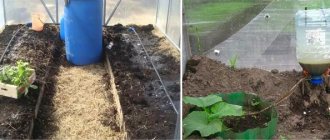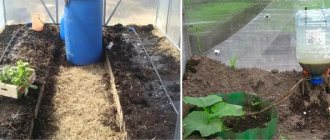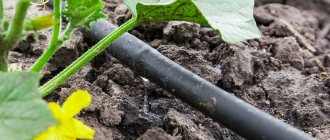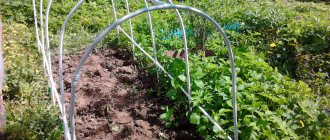The most labor-intensive task for a gardener is watering the beds. Especially if this has to be done in cramped greenhouse conditions. You can make your work easier by installing a drip irrigation system, which completely eliminates the need for exercises with watering cans and hoses. In this case, the yield will only increase due to the supply of water directly to the roots of the plants.
Drip irrigation from a barrel
Description and benefits
The drip irrigation method was first used in Israel in the fifties to combat water shortages. Soon scientists were able to find out that if the supply is made in small portions, then not only water, but also labor resources are saved. Moreover, drip irrigation allows for early harvests.
Conventional watering involves the penetration of moisture into the soil to a depth of 10 cm. And with a gradual drip feed, the root systems are more saturated with moisture, as a result of which they grow faster and, accordingly, receive more nutrients from the ground.
Greenhouse made of cellular polycarbonate
Water barrel
beds
Drip irrigation hose
Pump
A separate dropper is provided for each plant
On a note ! Since the soil remains dry, the risk of waterlogging is minimal. What has a positive effect on plant health is that many serious diseases (such as bacterial spot, blackleg, powdery mildew, etc.) develop precisely with excessive humidity.
Also, supplying water at the root reduces the risk of plant burns due to it getting on the leaves (a similar problem is explained by the lens effect, which is played by small droplets). Irrigation into the root zone reduces the rate of spread of weeds, because they do not receive enough moisture.
Important ! Distinguished by its extreme simplicity, the drip irrigation system helps increase productivity by about 30-40%. This method allows you to calculate both the intensity and time of watering for each specific crop.
Initially, drip irrigation was used only in greenhouses, but later it began to be used for growing in open ground.
A distinctive feature of systems for automatic watering from a barrel is the drip supply of water to the root zone
Distance between droppers-nozzles
The water supply in drip irrigation for a greenhouse made by yourself must be carefully adjusted. With low pressure, only those plants located at the beginning of the bed will be provided with water.
Excess water is also undesirable - the plantings will suffer.
For most crops, the distance between droppers is 30 cm
The types of droppers and dispensers and the distance between them should be selected depending on the type of plants being irrigated.
After all, there are no universal devices for watering:
- “spider” dispensers with a large distance between dispensers; they are best used for irrigating perennial greenhouse plants; do not use for open ground and watering seedlings, in this case a smaller distance between the droppers is required; water conduits for “spiders” are made only suspended
- for watering most crops, the distance between dispensers should be 30 cm
- droppers with a pitch of 20 cm are used for watering root crops - carrots, onions, etc.
- for melons and melons, the distance between the droppers is 1 m
What about the disadvantages?
The main disadvantage of do-it-yourself drip irrigation is the need for mandatory control. If you incorrectly calculate the amount of moisture, this can lead not only to excessive consumption, but also to the death of plants. The water level in the barrel will have to be constantly checked, topping up if necessary.
Note ! Another significant drawback is the need to periodically clean the holes (due to their small diameter, they often become clogged). Although there is nothing complicated about this, it is enough to simply blow or flush the system.
Drip irrigation has its disadvantages
We also note that the system should be protected from contamination, for which a filter is installed at the inlet, i.e. at the beginning of the hose, which is located in the barrel. An ordinary piece of foam rubber is quite suitable as a filter.
Types of droppers
Drippers are devices with small tubes at the end that cut into each of the holes in the hose or pipe to regulate the volume of water supplied.
Depending on the type of crops grown, the size of the plot and material capabilities, you can choose one of the types of drip systems.
Compensated drip
They are divided into:
- uncompensated and compensated: in the first case, the water supply at the end of the bed will be lower than at its beginning; compensated drippers, equipped with a membrane and a valve, are capable of dispensing water in doses even at different pressure levels; such devices are ideal for areas with height differences
- devices with a fixed volume of liquid supply (the manufacturer indicates it in the instructions): from 1 l/h
- with manual water flow
- equipped with an anti-drainage (compensated) system : they do not allow water to be completely removed from the system even when its supply is turned off; the pressure in them never drops to zero, so when switching on again there is no time required to displace air
- with spider-type dispensers: more expensive devices with drip irrigation for several plants at once
Whatever type of dropper you choose, always pay attention to the possibility of disassembling it. For such structures, the cover must be removed to clean the device from clogging.
TOP 3 ready-made kits for drip irrigation
The range of such equipment is quite large, but 3 models that have already been tested by summer residents deserve special attention.
Delta 3L-KP18
A set consisting of 60 droppers is designed for an area of no more than 18 square meters. There is overflow protection, expansion is possible by connecting several systems (a special adapter is used for this). The equipment is rich, you don’t need to buy anything in addition.
Circle Beetle
An inexpensive solution that has everything you need - from IVs and tubes to a timer. The maximum area of the greenhouse is also 18 square meters. Assembly is extremely simple, the hoses do not bloom. Available in 60 and 80 plant versions.
Start LCD AquaDusya
This set with an original and memorable name is highly appreciated by summer residents. The system is universal, suitable for berries, shrubs, fruit trees and flowers. It is equipped with a timer, droppers (70 pcs.), pump and everything necessary for installation. The only negative is the underground laying of the highway.
Delta 3L-KP18
Circle Beetle
Start LCD AquaDusya
1470 rub.
2765 rub.
5980 rub.
How to calculate the volume and duration of watering?
As mentioned above, first a plan is drawn up, which indicates the location of the crops in the greenhouse and the length of the beds. After this, an irrigation diagram is drawn indicating the location of the tank and supply pipelines. All this is necessary to correctly calculate the total length and number of droppers, adapters and other components.
Then the required volume of the barrel is calculated. For example, if the length of the line is 10 m, and the pitch between the nozzles is 30 cm, then 34 of them will be required. With a capacity of each dropper of 5 l/hour, it turns out that all droppers will flow about 170 liters during this time (1 hour).
Important ! With a longer length, the volume of the tank will have to be increased. Or divide the system into two (an alternative is to use a constant source of water instead of a barrel).
Anyone can make a simple version of a drip irrigation system with their own hands.
What kind of tank should there be for arranging irrigation in a country house?
Remote summer cottages are often cut off from the central water supply system, which makes caring for the crops much more difficult. Plants require abundant watering throughout the season, especially in hot and dry weather. If it is quite problematic to equip a well on the site, you can create your own storage facility where water will be accumulated and saved.
Anyone can afford to install an irrigation tank on their property. With its help, timely watering is organized, and a prototype of a water supply system is created, which allows the liquid to be used for various purposes.
Master Class. Organization of drip irrigation in a greenhouse
Let's consider the process of arranging the system using the above-mentioned “Beetle” kit, which is produced in the city of Kovrov.
Drip irrigation in a greenhouse from a barrel
Operating instructions for the “Zhuk” drip irrigation kit . Downloadable file (click on the link to open the PDF in a new window).
User manual
Step 1 . First of all, we cut a hose along the length of the beds (in the example - 3 pieces), lay it out over the beds and secure it with clamps. We place a tap/plug at the beginning/end of each segment. We connect the segments, take one to the tank.
The cuttings need to be laid out in beds
Step 2 . Using an awl (it usually comes with the kit), we make holes with the required spacing and install the droppers.
Installation of droppers
Step 3 . As a result of the actions described above, the system in the greenhouse looks like this.
What will the irrigation system look like?
Step 4 . We organize a place for water supply. Since the tank must be raised above ground level (for a pressure of 0.1-0.2 atmospheres the required height is 1-2 m), we build a pedestal from an old refrigerator, and it, in turn, is installed on a special platform, previously made from four paving slabs.
Organization of water supply point
Step 5 . We connect the hose to the barrel. We drill a hole in the latter corresponding to the diameter of the fitting and connect it to the previously laid hose through a fine filter.
Connection of a barrel with a hose
Step 6 . We attach a transparent tube to the tank and hose so that in the future we can determine the water level.
Transparent tube fixed
On a note ! To better see the water level in the barrel, you can place a bright floating ball in a vertical tube.
Tube for determining the water level in a barrel
Step 7 . At the end we paint the refrigerator, and cover the barrel with a lid of a suitable size, otherwise a lot of debris will get inside. That's it, the drip irrigation system is ready, now to start it you just need to open the hose.
Ready-made drip irrigation system from a barrel
Video – Drip irrigation system “Zhuk”
What materials are storage containers made from?
Containers for storing and supplying water are presented on the market in various versions and are made of metal or durable plastic. When buying a container for watering for a long time, you should consider what material it is made of. Modern polymers make it possible to create very durable products with high technical characteristics. They can surpass their metal counterparts in quality and strength.
Metal
Metal storage tank
A tank made of this material is a classic option, familiar to most summer residents. Iron products have been used to store liquids for many years. Everyone who works in the country and uses an artificial storage device made of metal knows about all its disadvantages:
- susceptibility to corrosion;
- rapid contamination;
- difficult care.
It is quite difficult to protect a metal tank from destructive corrosion. To maintain its integral appearance from the outside, it is enough to paint the surface. But inside the water will create a constant impact that destroys the metal. Within a couple of months, sediment will form at the bottom of such tanks. Internal cleaning is a difficult task. The positive side is the good heating of the barrel and its contents under the rays of the sun.
You can maintain the integrity of the inside of the tank by using a plastic lining. This is the only option. However, such an expensive undertaking is not available to everyone.
An alternative solution would be to purchase a stainless steel product that does not have these disadvantages. This also applies to the option with high financial costs.
VIDEO: Irrigation barrel, making a stand
Durable plastic
Purchasing an irrigation tank of 500 liters or more is a reasonable decision, based on the fact that they do not have the disadvantages of metal structures. Such products are made of high-tech plastic, which allows them to withstand heavy loads. Unlike cheap plastic, they are not afraid of temperature changes. Integrity is also maintained under the influence of high water pressure.
Plastic container for watering
One of the main advantages of plastic tanks is their light weight. They are easy to transport and install in the required location. You can install the plastic structure yourself without special equipment.
To prevent the tank from bursting when the water freezes in winter, either drain it completely, or throw a large log or plastic 5-liter bottles inside, which completely cover the surface.
To make a large-volume watering container, it is additionally reinforced with special metal rings. This design makes the final product resistant to water pressure. The next advantage of products made from plastic is price. It is more affordable than metal analogues. The manufacturing technology of plastic containers allows us to offer the buyer containers of various shapes:
Master Class. Using a “crying” PVC hose
To simplify the work, if watering is designed for 1-2 beds, you can use the method described below.
Step 1 . First, unpack the purchased hose. In the example, this is a “crying” (oozing) type model made of PVC.
Unpacking the hose
Step 2 . We unwind the hose and lay it along the plants (the photo shows flower beds, but the method is also applicable to beds).
Step 3 . We connect the hose to the fitting, and it, in turn, to the water source.
Connecting the hose to the water supply using a special fitting
Step 4 . We install a plug at the other end of the hose.
Stub
On a note ! All that remains is to open the tap and start the system. Upon completion of the process, the plug is removed, the remaining water is drained from the hose and it is moved to the next bed.
Tips for using the system
Here are some useful tips for using a drip irrigation system.
Drip irrigation is a reliable way to save water without compromising the quality of irrigation
- The components used have a small diameter, and therefore the system becomes clogged from time to time. Cleaning will help restore its capacity, which can be done either manually or mechanically. Moreover, special attention is paid to droppers - they need to be disassembled and cleaned of contaminants.
- If rust appears in the water, components and fittings are checked. Instead of metal parts, you can install plastic ones, and the strength of the connections will not be affected. If the filter fails, this is also not a problem - you can replace it with a foam rubber insert (it needs to be cleaned weekly).
- The sealed lid will protect the system from foreign particles and debris.
- After watering, the soil around the plants is loosened or, alternatively, mulched.
FAQ. Frequently asked questions about drip irrigation
Does drip irrigation affect soil compaction?
Yes, there is a slight decrease in level, a decrease in volume. To provide air access to the root system, you can use a pitchfork to puncture the soil. And in the fall, dig up the area.
Should the tape be buried for watering seedlings? What pitch between holes is required?
It does not matter where exactly the water source will be located. As for the step, it depends on the length of the row and the structure of the soil. If the soil is sandy, then the required step is 10-20 cm, if it is medium-grained, then 30 cm. If the planting row is long, a distance of about 40 cm is maintained.
Why does a tape with emitters water poorly?
In this case, you need to check how high the water tank is above the ground. Its optimal height is about 1.8 m.
How to store drip tape?
During operation, we recommend avoiding excessive pressure and mechanical damage. In winter, you need to wind the hose onto a reel, but so that it does not bend or break. Store in a room with temperatures above zero.
Phytosporin in the greenhouse: we treat beds, walls, plants
Criteria for building the best greenhouse: what to look for?
DIY greenhouse: review of popular designs
Rules for organizing watering of various crops in a greenhouse











